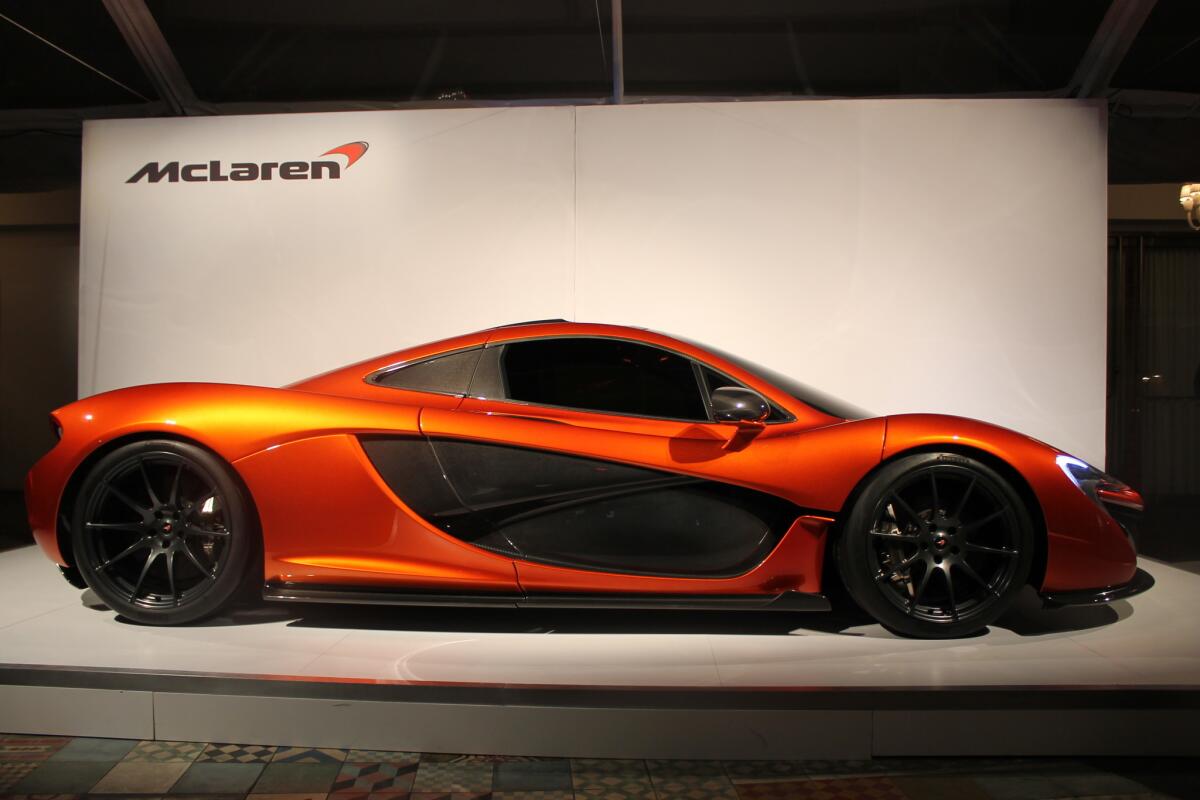McLaren’s next supercar makes L.A. debut

McLaren’s forthcoming million-dollar P1 supercar made its Los Angeles debut Thursday night. It was every bit the premiere you’d expect in Hollywood.
A crane dropped the P1 into place at the SLS Hotel. Jay Leno got an exclusive look at the interior. There was an open bar; there were cupcakes with the McLaren logo on them; and the crowd was dotted with statuesque women grasping the arms of shorter, older men.
But the real eye candy was in the center of the room, on a well-lit stage, wearing a brilliant shade of metallic orange.
Photos: McLaren’s P1 supercar makes its L.A. debut
For those unfamiliar with McLaren’s P1, it’s an ultra-high-performance car headed to market at the end of 2013. It applies to a road car the company’s considerable Formula 1 racing experience. McLaren doesn’t even like to call the P1 a supercar; this is a hypercar. Rather, the automaker prefers to keep the “supercar” moniker for its only other product, the lesser MP4-12C. Which sells for $250,000.
The P1 will compete in a more elite segment that includes vehicles as rare as they are quick. Think Bugatti Veyron, Pagani Huayra and Koenigsegg Agera R. All have many hundreds of horsepower and top speeds north of 220 mph, and they cost more than $1 million.
McLaren is mum on powertrain details for the P1, choosing instead to reveal them, along with the car’s interior, at the Geneva Motor Show in March. But it’s likely that the car will draw between 800 and 1000 horsepower from a twin-turbocharged V-8 engine.
Like the P1’s spiritual successor, the now-legendary F1 supercar from the 1990s, that engine will sit in a bay lined in gold foil to better deflect heat. All this will be in a vehicle that McLaren expects to weigh less than 2,900 pounds, or about the same as the average compact car.
McLaren probably will make just several hundred copies of the P1, and the car will cost about $1.2 million. It’s one of several new additions to the hypercar club for 2013; Ferrari will soon introduce the successor to the Enzo, and Porsche is hard at work on the all-new 918 plug-in hybrid.
For now, all McLaren is making public is the car’s strikingly unique exterior. The automaker says this model making the publicity rounds is 97% of what the production car will look like. The body panels are all carbon fiber, as is the central tub.
The man responsible for the P1’s unique look is Frank Stephenson. He’s been with McLaren since 2008, and though he had a hand in some of the design of the 12C, the P1 is the first McLaren he’s shaped from a blank sheet of paper.
Stephenson said the car’s aesthetics are very much form following function.
“A lot of the car has actually not being styled or designed to look good, it’s been designed to function properly,” Stephenson said at the unveiling. “It’s almost as if you took a sheet and draped it over the hard points of the car and let it settle. This pretty much gave us the ultimate shape of the car.”
“Hard points” refers to parts of the car whose position can’t be changed or altered for the sake of aesthetics, like the suspension or the driver’s position.
Also influencing the P1’s look is an emphasis on generating as much downforce as possible. Downforce is created by the car’s body, which uses air moving over and under the car to hold it to the road. This explains the many air vents, intakes, outlets and front and rear diffusers.
By maximizing the downforce, the car’s grip of the road is improved, which gives drivers more control at higher speeds. Stephenson said the P1 was designed to exert immense amounts of downforce at lower speeds than is possible on other supercars. This McLaren can generate the downforce at 80 to 90 mph that other supercars might need 150 mph to produce, Stephenson said.
Because there are fewer roads where drivers can hit 150 mph than 80 mph, Stephenson says this broadens the appeal of the P1 and makes it more applicable in more situations.
Some of these principles gleaned from Formula 1 racing and the development of the P1 will trickle down to the next McLaren car, currently called the P13, Stephenson said.
The “entry-level” P13 is to be smaller and less expensive than the P1 and the 12C. It will target the upper end of the Porsche 911 range -- think Turbo or GT3 -- when it comes to market in the next several years. It will take design cues from the P1 but wrap them in a more practical package that includes things like an actual trunk.
For now, Stephenson is happy to show off the P1 halo car and the advancements in design and performance that it represents for McLaren.
“This car has to be the ultimate expression,” Stephenson said, “the calling card of our technology.”
ALSO:
Full coverage: 2013 Detroit Auto Show
Photos: McLaren’s P1 supercar makes its L.A. debut
Photos: Sitting shotgun in Porsche’s upcoming 918 hybrid supercar





